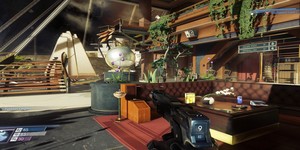
Prey Review
Price: £40Developer: Arkane Studios
Publisher: Bethesda
Platform(s): PC, PS4, Xbox One
Version Reviewed: PC
Prey wears its influences on its space-sleeves. It's a Shock game, handing you a wrench and turning you loose into an expansive world filled with dangerous enemies and a series of puzzles for you to tackle however you wish.
It feels so similar to System Shock 2, in fact, that you would be forgiven for thinking it was the third entry in that series or that it was a spiritual successor, Kickstarted by the original creators as a last-ditch attempt to cash-in on the series' success.
What it doesn't feel like is the original Prey, but that was a fairly by-the-numbers shooter with a cool portal system and a series of doors that looked like gaping anuses. Instead of those treats, we get Prey's alternate-history look at the space race, culminating in the space-station Talos 1, one of the game's most tremendous achievements: a space-station that feels like it was a place that people lived and worked. Before the alien Typhon overran the place and killed everyone, that is.
Talos 1 is the real star of Prey, a space-station that you'll be exploring and exploiting for much of the game's 20 hour run-time. I regularly found myself revisiting older areas to explore, watching the space station slowly coming apart under the alien influence. Formerly safe areas become breeding grounds for the alien menace, and you'll slowly start unlocking shortcuts to skip out less savoury places on your journey, like the zero-gravity cargo chute dubbed the G.U.T.S. of the ship or several alien-infested labs and offices.
Developers Arkane have imbued Talos 1 with a sense of character, and you see it playing out in the environmental details: an office filled with packing crates, a HR computer filled with emailed complaints for perceived slights, or even the genre-classic of a tape-based voice recording. The sprawl of familiar departments was expected: hardware, medical, evil sciences. More unexpected was the presence of the several support areas: The HR and sales departments might not bring as many opportunities for cool set pieces, but they do a lot for making Talos 1 feel like a big workplace.
A nice touch is that every corpse you find and some of the enemies you fight are named. It's rewarding to follow the paper trail and find emails where a guard complains about the 'volunteers' he's responsible for imprisoned on the space station and see him asking for help repeatedly, then finding an inmate leaving him a note offering him information, before finally finding him and the other inmate killed not by the Typhon but by the other volunteers in the confusion. 'I'm trying to escape now through the vents!' says an urgent note signed by a doctor. Later, you find the doctor tangled up in fallen rubble. She didn't make it.
The game weaves 100 stories just like this one throughout its main narrative, the ever shifting tale of Morgan Yu, a male/female scientist of German-Asian heritage who might just be responsible for this whole mess. Morgan starts the game knowing no more than the player, although Morgan's fingerprints are everywhere, on emails asking for extra supplies, on voice logs, in the giant office that Morgan stocked up with supplies before forgetting everything.
It's a masterclass in environment design, although I wish there was a put-down button, because my sole interaction while quietly exploring was to accidentally pick up books for a closer look and then launch them at light-speed out of the nearest window. But this environmental design is also where the game generates a lot of its scares, primarily because the game's early antagonists are the Mimics, eerie pricks that skitter around the station becoming perfect duplicates of everyday objects. Two chairs knocked over next to a corpse could be environmental storytelling, or it could be a Mimic in disguise, waiting to mess you up.

MSI MPG Velox 100R Chassis Review
October 14 2021 | 15:04














Want to comment? Please log in.